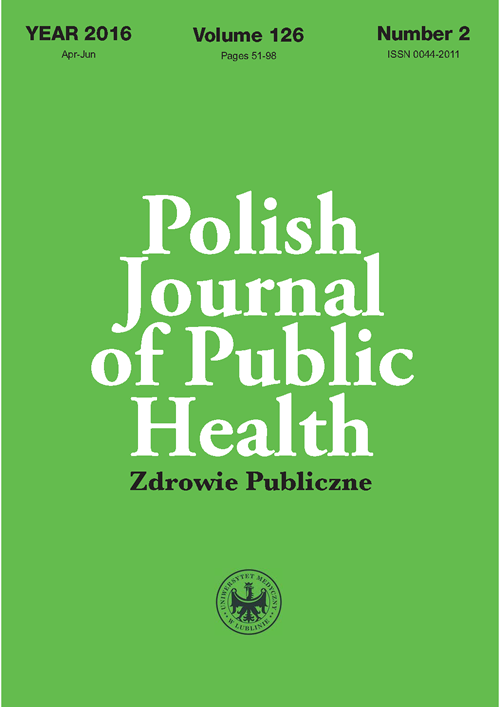Variations of Peak Expiratory Flow Rate associated with various factors among healthy adults in a city setting
DOI:
https://doi.org/10.1515/pjph-2016-0019Keywords:
pollution, pulmonary function tests, spirometry, PEFR, BMIAbstract
Introduction. Peak Expiratory Flow Rate (PEFR) was first described by Hadorn as a measure of the lung function. The definition of PEFR established by the European Respiratory Society defines it as the maximal flow achieved during the phase of expiration, delivered with maximal force and starting from the maximal lung inflation level.
Aim. The authors of this study attempted at evaluating the variations of PEFR, taking into consideration the effects of one’s age, height Body Mass Index (BMI), Body Surface Area (BSA), seasons of the year and air pollution. Healthy adults living in urban areas were subjects of the study.
Material and methods. The study group consisted of some 179 healthy subjects, 102 women and 77 men, aged 18 to 66. Every patient’s medical history, including epidemiological, demographic data, as well as the information about the occurrence and symptoms of lung diseases, was taken from every patient. Only healthy subjects were selected for further analysis. Participants performed spirometry testing. Physical parameters were measured. Appropriate pollution data was obtained.
Results. The study group consisted of 179 patients (102 women and 77 men). There is a negative correlation between PEFR and age and a positive one between PEFR and height, as well as Body Surface Area and BMI (regarded as a quantitative, but not as a qualitative trait). There is a significant correlation between PEFR and PEFR adjusted by age, height and weight with seasons of the year. There is a statistically significant negative impact of NO2, SO2 and O3 24 h mean and hourly NO2 concentration on PEFR.
Conclusions. Peak Expiratory Flow Rate changes are also present in a healthy adult population. Prevalence of obesity is an important factor of the examined population.
References
1. American Thoracic Society. Standarization of spirometry. Update. Am J Respir Crit Care Med. 1995;152:1107-36.
2. Quanjer PH, Lebowiz MD, Gregg I, et al. Peak expiratory flow. Conclusion and recommendations of a working party of the European Respiratory Society. Eur Respir J. 1997;10(Suppl.24):2S-8S.
3. Cook NR, Albert MS, Berkman LF, et al. Interrelationships of peak expiratory flow rate with physical and cognitive function in the elderly: MacArthur Foundation studies of aging. J Gerontol A Biol Sci Med Sci.1995;50(6):M317-M323.
4. Thomas PS, Harding MR, Milledge JS. Peak expiratory flow at altitude. Thorax. 1990;45(8):620-2.
5. Frischer T, Kühr J, Meinert R, et al. Relation between response to exercise and diurnal variability of peak expiratory flow in primary school children. Thorax. 1993;48(3):249-53.
6. van der Zee S, Hoek G, Boezen HM, et al. Acute effects of urban air pollution on respiratory health of children with and without chronic respiratory symptoms. Occup Environ Med. 1999;56(12):802-12.
7. de M Correia-Deur JE, Claudio L, Takimoto Imazawa A, Eluf-Neto J. Variations in Peak Expiratory Flow Measurements Associated to Air Pollution and Allergic Sensitization in Children in Sao Paulo, Brazil. Am J Ind Med. 2012;55(12):1087-98.
8. Ward D, Roberts K, Jones N, et al. Effects of daily variation in outdoor particulates and ambient acid species in normal and asthmatic children. Thorax. 2002;57(6):489-502.
9. Janssens JP. Aging of the respiratory system: impact on pulmonary function tests and adaptation to exertion. Clin Chest Med. 2005;26:469-84.
10. Jepegnanam V, Sulochana A, Swamy D, Rao VM. .Peak expiratory flow rate in a random healthy adult population of Coimbatore. Indian J Physiol Pharmacol. 1996;40(2):127-33.
11. Suresh S, O’Callaghan M, Sly P, Mamun A. Impact of childhood anthropometry trends on adult lung function [Epub ahead of print]. Chest; 2014.
12. Biring M, Lewis M, Liu J, Mohsenifar Z. Pulmonary physiologic changes of morbid obesity. Am J Med Sci. 1999;318(5):293-7.
13. Fukahori S, Matsuse H, Takamura N, et al. Body mass index correlated with forced expiratory volume in 1 second/forced vital capacity in a population with a relatively low prevalence of obesity. Chin Med J. 2010;123(20):2792-6.
14. B. Chakrabarti, Purkait S, Gun P, et al. Chronic airflow limitation in a rural Indian population: etiology and relationship to body mass index. Int J Chron Obstruct Pulmon Dis. 2011;6:543-49.
15. Schachter L, Salome C, Peat J, Woolcock A. Obesity is a risk for asthma and wheeze but not airway hyperresponsiveness. Thorax.2001;56(1):4-8.
16. Yamazaki S, Shima M, Ando A. Effect of hourly concentration of particulate matter on peak expiratory flow in hospitalized children: A panel study. Environ Health; 2011.
17. Pujades-Rodríguez M, McKeever T, Lewis S, et al. Effect of traffic pollution on respiratory and allergic disease in adults: cross-sectional and longitudinal analyses. BMC Pulm Med. 2009;9:1-11.
18. Higgins BG, Francis HC, Yates CJ, et al. Effects of air pollution on symptoms and peak expiratory flow measurements in subjects with obstructive airways disease. Thorax. 1995;50(2):149-155.
Downloads
Published
Issue
Section
License
Copyright (c) 2016 Polish Journal of Public Health

This work is licensed under a Creative Commons Attribution-NonCommercial-NoDerivatives 3.0 Unported License.


